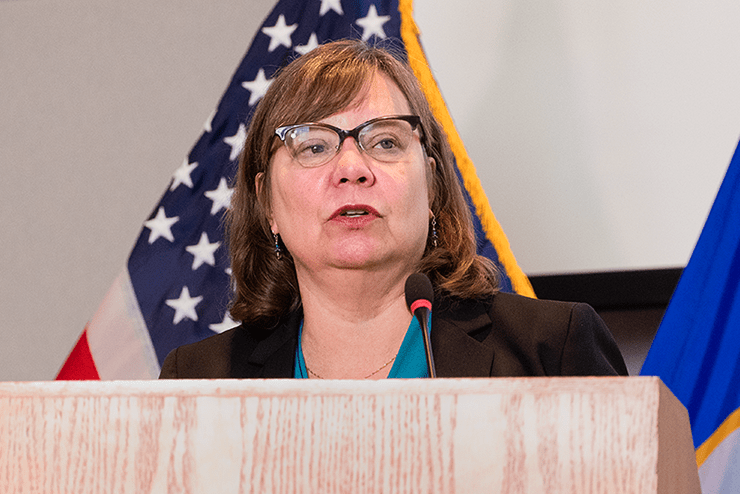
The Latest: Maryland to ease COVID restrictions this week
March 9, 2021
The Latest: Alaska opens vaccines to all 16 or older
March 10, 2021It’s not a new issue for rural America, but 2020 moved it to a critical mass.
And it’s all summed up in one keyword — broadband.
The importance of connectivity in all areas of life was part of the annual meeting for the Brainerd Lakes Area Economic Development Corp. The session typically brings together government leaders and representatives across the business spectrum. This time, people gathered from their homes and offices at 7:30 a.m. Tuesday, March 9.
Shirley Bloomfield, CEO of the National Telephone Cooperative Association – the Rural Broadband Association, which represents nearly 850 independent telecommunications companies, was the keynote speaker. Bloomfield was named one of the most influential people in Washington by Washingtonian magazine.
Shirley Bloomfield, CEO of NTCA–The Rural Broadband Association, which represents nearly 850 independent telecommunications companies, has more than 30 years of experience representing the country’s smallest telecom operators. She was the keynote speaker Tuesday, March 9, for the virtual Brainerd Lakes Area Economic Development Corp.’s annual meeting. Submitted photo
Tyler Glynn, BLAEDC executive director, said Bloomfield was an expert on the role of federal communications policies in sustaining the vitality of rural and remote communities and the benefits of rural broadband networks for millions of American families, businesses and the economy.
“So what I wanted to just share a little bit today is a little bit about broadband deployment, why it matters, why it’s harder than you think and where we stand as a country,” Bloomfield said, noting her talk was following Kristi Westbrock, CEO/general manager of CTC, who gave an overview of the company’s efforts and broadband in central and northeastern Minnesota. Bloomfield said Westbrock is one of the rock stars she looks up to and the community may not realize how lucky they are to have Westbrock.
“I do think that we’re at such an interesting point in our country because, for example, we wouldn’t even be able to have this discussion if it weren’t for the broadband that is provided in your communities. So you know I think about how much we’ve learned over the course of the past year and why that matters on a federal policy front.”
Bloomfield pointed to the rural electrification of the 1930s that focused on bringing electricity to rural areas where companies hadn’t reached because fewer people made the cost of the service so high. Serving the high density urban areas was relatively easy. That meant rural America was left behind. Cooperatives like CTC filled the gap.
Fast forward to the present where being able to connect to the internet with a reliable service comes with opportunities for education, telemedicine, commerce, business growth and quality of life. Bloomfield said the beauty of the cooperative model is one that is built not on profit but on service. Minnesota, she said, is a stronghold for cooperatives. In rural America, those cooperative members see their customers at schools, in churches and at local stores.
“That makes a really big difference,” Bloomfield said.

Tyler Glynn, Brainerd Lakes Area Economic Development Corp. executive director.
Bloomfield has worked with every campaign and all parties, recently working with the Trump administration. She was also on candidate Joe Biden’s innovation committee where she said it was heartening to have broadband front and center with money devoted to the issue varying between $20 billion to $100 billion.
“Thinking about broadband as infrastructure and thinking about it as essential is really important. Now where I would draw the line is, I’m not so crazy about governments thinking they can build a network themselves because, Kristi would be the first to tell you, it is hard. It is complicated, it’s expensive, and so many times companies, or governments who get into it and think that it’s a one time proposition. ‘I’ve got $5 million. I’m going to put it in the ground.’ That’s, it’s like buying a dog, that’s just where you start.”
Bloomfield spoke of her own short experience working for a large provider where the CEO noted they weren’t interested in selling properties to smaller carriers because they didn’t have to upgrade the service and without competition the areas were cash cows.
“And I thought, wow, you have just articulated why you are leaving rural America as kind of second class citizens,” Bloomfield said. “But I do think that we as a country have learned so much during this pandemic. And I think nationwide there’s a ton of attention. Federal policymakers, really significantly for the first time, really focused on, ‘What does it mean to have unserved Americans?’ What has happened during this pandemic when people couldn’t work from home, kids couldn’t learn from home? Students are going to a McDonald’s parking lot to get connectivity. They don’t have a CTC in their backyard to proactively think about how you serve those students at home.”
Bloomfield said it’s hard to pin down the number of Americans who are unserved or underserved.
“We know it’s well over 15 million,” she said. “It could be as high as 30 or 40 million. But the important thing is we’ve got this moment in time where we can really take what we’ve learned during this pandemic and apply it as we think about national policy, because we just finished one round of stimulus that the House will vote on tomorrow, which I think will be interesting for all of you.”
One of the opportunities, Bloomfield said, is an emergency benefit for students and connectivity.
Those are things, she said, the country should have been thinking about eight months ago. Last September, Bloomfield said, the country should have been a little bit ahead of the curve.

Having fiber-optic cable for broadband provides an ability to send data faster and with greater bandwidth, which comes into play for video, internet and voice services. That value is visible when it comes to reselling homes, growing businesses and bringing in new companies. Bloomberg pointed to the need for data and speed when students are home distance learning while parents are trying to work from home. In addition, she said they’ve learned people need to be able to upload as fast as they download, which wasn’t previously the case when it was about downloading an article or email.
“Well now we need to be able to transmit both ways just as fast, that’s a symmetrical network. And that is what fiber can provide,” Bloomfield said, noting as Congress looks at infrastructure, it’s broadband connectivity that is the 21st century superhighway.
To really understand what areas are underserved or not served at all, Bloomfield said mapping is needed. “Congress finally appropriated some money to actually start mapping, that’s going to be a really important first step,” she said. Bloomfield said looking at programs the FCC is considering, it’s going to take about a decade to get the country to 90-95% coverage.
Another important step is to look at what is the best use of federal programs and to avoid overbuilding what has already been put in the ground with programs such as the ones CTC has already utilized to extend service to rural communities. State partnerships need to be incentivized. Bloomfield said she met with 35 states recently and their state broadband offices and she told them the Minnesota Border-to-Border Broadband Development Grant Program, funding expansion of broadband to the unserved or underserved, was the best run program she’s seen out there.

“The other thing I would say is, we’ve got to be thinking a little bit creatively about partnerships,” Bloomfield said, noting CTC as an example and adding if she could have more people with a vision like Westbrock, she thinks the country would be further along.
“And the last thing I would say in terms of things that we’ve learned is we’ve got to aim higher and do better,” Bloomfield said. “Right now I’ve seen a big initiative for people to plug in holes with what I would call really substandard technology.”
Fixed wireless products are suggested as a fix for rural communities. Bloomfield described that as a Band-Aid. She said it’s cheaper to do it right the first time. With the interest in 5G and its increased speed and capacity, Bloomfield said it still needs a fiber backbone. She held up her cellphone noting people might think when they place a call to another cellphone, it’s a direct line, but it actually goes from one cellphone to a tower using fiber to connect to another tower.
Looking at smart automobiles, smart energy and precision agriculture, Bloomfield said she thinks fiber is the key but then comes thinking about what can be layered on top of it that will make things more efficient, effective and innovative.






